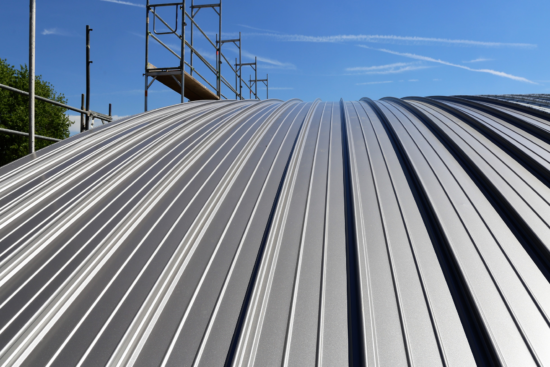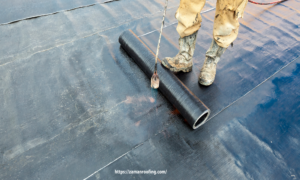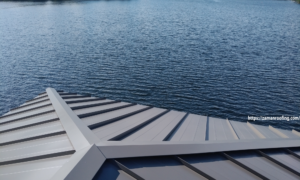© All Rights Reserved | Roof Replacement and Repair - Zaman Roofing LLC. | Website Design & CT SEO Powered by High Point SEO CT
- Google Rating5.0Based on 33 reviewsZaman Roofing - CT Roofing Contractors & Roof Repair5.0Sergey Y."Zaman Roofing” recently completed a roof replacement project in our condo complex, and we are extremely satisfied with their service. From start to finish, their team demonstrated professionalism, efficiency, and exceptional craftsmanship. They were prompt in their communication, providing detailed explanations and answering all our questions. The crew arrived on time, worked diligently, and completed the project within the estimated timeframe.Not only did Zaman Roofing exhibit outstanding technical skills, but they also ensured minimal disruption to our daily activities. They took great care to protect our property, cleaning up thoroughly each day and leaving no trace of debris behind.The quality of the new roof is outstanding. Zaman Roofing used top-grade materials and paid attention to every detail, resulting in a sturdy and visually appealing finished product. The roof has significantly enhanced the overall appearance of our condo complex.We would highly recommend Zaman Roofing to anyone in need of roofing services. Their professionalism, expertise, and attention to customer satisfaction make them a reliable choice for roof replacements. We are grateful for their excellent work and would not hesitate to hire them again in the future.Christopher Z.Zaman Roofing was AWESOME!!!! This is my third time doing a roof in CT on my third home and Zaman did an outstanding job on my rather unique roof line. They even replaced a skylight. I needed a Roof Contract in place before insurance would allow the purchase because the seller was a DeeBag. Zaman worked with my realtor, banker, etc and even waited patiently while the seller delayed the process by 4 months. The week I closed, Zaman Roofing was up and at em. Stripping, prepping and replacing. In and Out. Property was nice and clean after the work was complete. I would highly recommend.Steve TZaman Roofing, located in Berlin, CT, truly excels in providing top-notch roofing services. I am absolutely thrilled to give them a well-deserved 5-star review for their outstanding work. They have proven themselves as experts in roofing Berlin CT, and I couldn't be happier with the results.When it comes to roofing in Berlin, Zaman Roofing stands out from the competition. Their team of skilled professionals demonstrated exceptional attention to detail during the installation of my new roof. They meticulously handled every aspect of the project, ensuring both aesthetics and durability were top-notch.What impressed me the most was Zaman Roofing's commitment to customer satisfaction. From my initial contact with them, they were responsive, courteous, and eager to understand my specific roofing needs in Berlin. Their exceptional customer service throughout the entire process made me feel valued as a client.Zaman Roofing's expertise in roofing Berlin is truly commendable. They have an extensive portfolio of successful projects throughout Berlin, CT, showcasing their skill and knowledge in a variety of roofing styles and materials. Regardless of the complexity of the job, they have the necessary resources to deliver exceptional results.I cannot emphasize enough how satisfied I am with Zaman Roofing's services in Berlin, CT. Their professionalism, reliability, and dedication to their craft are unparalleled. If you're searching for exceptional roofing services in Berlin CT, Zaman Roofing is the company to choose. They will exceed your expectations in every way.In conclusion, Zaman Roofing unquestionably deserves a stellar 5-star rating for their exemplary roofing services in Berlin, CT. Their expertise in roofing Berlin and roofing Berlin CT shines through in their exceptional workmanship and customer service. I highly recommend Zaman Roofing for all your roofing needs.Gary G.Zaman replaced the roof on my 2,200 sq. ft. colonial in 2015. The workmanship was perfect. Unfortunately, over time, the top-of-the line shingles discolored. He was totally supportive in getting the manufacturer to replace them at no cost to me. He just replaced the roof with the new shingles. It was another perfect job. It was completed in one day. The crew was great and they cleaned the area spotless.Chris DWe used Zaman Roofing for our Roof and Gutter Replacement, I acquired 5 quotes for the work and found Zaman to be the most reasonable, it was a Good Decision to choose Zaman Roofing, Seweryn was Professional in every aspect and the Clean-up was nothing short of Amazing, I would Highly Recommend using Zaman RoofingRobert D.Excellent Service and Value - great crew and easy to deal with - highly recommended !Sunghoon P.Great work and reasonable price. I am so happy with their service. I asked a bunch of questions before and after the service and his responses were very prompt and straight to the point. Highly recommend.Adrienne M.I am so pleased that I used this company. My new roof looks fantastic. Such a hard working crew. Seweryn was informative and professional. Price was very completive. Don't hesitate to use them you will be very satisfied. Highly recommend!Nancy M.Good communication, timely response and knowledgeable. Very happy with our experience and highly recommend this company.Beata M.We used Zaman for our roof replacement recently and are very pleased. They replaced our roof in one day and gave us a very competitive quote. Good quality of work. Highly recommended.Lori K.They were here when they said they would. Professional & left everything neat ,cleaned up everything. They were in & out in a day & a half. Would recommend Zaman roifing.Dan R.A+ service, professional and quick response time.Anna G.Zaman and his crew provide great workmanship they installed new roofs they take great pride in the work they do. They were punctual and did a amazing job with the roof installation and clean up. Highly recommend Zaman Roofing to family and friends. Thank you for the opportunity to work with such a amazing contractorScott M.Awesome contractor, I would highly recommend him to family & friends. Seweryn & his crew were here on time & worked diligently. They were the happiest workers I've ever dealt with (I am a former construction project manager with the Federal government). Any & all questions were answered. My neighbors couldn't believe they finished the job in one day & complimented how great the new roof looks.Clement D.Great roofing contractors. I love to recommend it to my friends and family.Karen 9.With the quality, price, timeliness, all round nice guy and great crew, Zaman Roofing LLC is what other companies aspire to be.... Clean, helpful and a pleasure to recommend....james C.Excellent experience from start to finish, all appointments and work times met in a timely fashion, workmanship and clean up left nothing to be desired.Would be a definite recommendation, very pleased.Margaret B.I had obtained multiple quotes and did my due diligence research and Seweryn Zaman came back with fair price and good recommendations. He was professional, explained everything that he was going to do and never once he rushed me during decision process. He showed up on time with his hard working crew and finished my roof in one day. I was amazed with his crew who worked like busy bees. Very impressed with the clean up process and the end product. Two months after he finished my roof he was still helping me deal with the insurance company making sure I had everything I needed. Thank you SewerynSteve B.Very professional and easy to work. The crew came in, replaced my roof and then cleaned up everything! Highly recommended.Jim O.Competitive quote among four others. Seweryn Zaman provided larger color samples of the shingle colors we were interested in. He obtained the building permit, showed up on the day expected with his entire crew. Our older roof was on 24" trusses and needed more plywood replaced than anticipated. He got the additional sheets replaced on the day of the re-roofing. The crew worked with him late until the job was done and picked up every piece of old debris. The roof passed final town inspection with no concerns. Zaman Roofing is easy to deal with; he's responsive on text messages and phone calls. I used them in the past for an emergency repair and he found a well-hidden leak from the builder.Dale C.The crews did a good job, and the leader of the crew did a great job when they replaced the roof of my house in Farming on 7/6&7 this year. When they worked on the project, they worked professionally and in detail. We are very pleased with the work they have done, and highly recommend people to have the company worked on their roof projects.Forrest B.Zaman's was very professional, excellent quality of work and very responsive to our needs. This roofing experience was excellent from start to finish and provided an excellent value. Would certainly recommend them to any friend.Yonatan M.We used Zaman Roofing to replace our roof in 2019 and could not be happier with the service and product. A highly professional company and great personal interaction with the owner. The workers took great care of our landscaping, and the owner was there frequently to supervise the work and take care of finishing touches like flashing the chimney. We have had zero issues since then and highly recommend this company.Quinn V.Zaman was awesome. He was communicative, on-time, and was able to give me a quick inspection of our roof despite the rain. I rarely have a contractor tell me that I didn't need to spend any money, but Zaman told me my roof was fine for the next several years.magdalena K.We recently used Zaman Roofing to replace our 26-year-old roof. Right from the start they were great! Sevy was extremely professional and knowledgeable and gave us a great quote. Everything was done as they described and the final project looked great. The owner was on the job from start to finish as he promised.Ariadna G.Our experience with Zaman Roofing was excellent. I was very impressed with both their work and their customer service. Seweryn was very knowledgeable and professional.Larry G.What a wonderful business. Very responsive. They showed up exactly when expected, completed the project quickly and accurately and left no trace after clean up. All with a very competitive price. I would highly recommend Zaman to anyone looking to have roofing work done.STEVE R.I was very pleased with the roof and gutter repairs performed by Zaman Roofing on two of my buildings. Good workmanship and fair prices, I would recommend and use again.Danielle D.These guys stripped and reshuffled my roof is 1 day! They did an awesome job. Roof is beautiful. He uses a dump trailer which is great and they cleaned up well. Very happy with the work. Also pricing was fair.

Suggestions for Waterproofing a Standing Seam Roof
Category: Roofing • August 19, 2023
In our latest blog post, we discuss waterproofing standing seam roofs. You know this sleek, modern roofing design is durable and attractive if you possess it. Can it survive the elements? Waterproofing helps.
We’ll discuss waterproofing solutions, their pros and downsides, and the finest materials for your standing seam roof to help you choose one. Grab a cup of coffee or tea (or whatever your taste buds choose) while we reveal the roof watertightness secrets!
What is a Standing Seam Roof?
The sleek and stylish standing seam roof has grown in favor. Vertically oriented panels with elevated seams interlock to seal water. Standing seam roofs have elegant lines and are more durable than traditional roofs, which leak.
One of the main benefits of a standing seam roof is water drainage. The elevated seams drain rainwater away from the surface, eliminating pools or leaks. This makes it ideal for rainy or snowy situations. In addition to waterproofing, a standing seam roof has other benefits. The clean design lends contemporary elegance to any architectural style, increasing curb appeal and home value. Its secure interlocking mechanism also makes this roofing system wind-resistant.
Installation of standing seam roofs requires expertise and equipment. For optimal waterproofing, choose experienced technicians who understand the complexities of correct installation.
Standing seam roofs are attractive and durable, keeping your property dry and protected in any weather!
The Different Types of Waterproofing Systems
There are various waterproofing solutions for standing seam roofs. It’s crucial to know your options because each system has pros and cons.
One waterproofing system is a liquid-applied membrane. A liquid coating is applied directly to the roof surface to create a seamless water barrier. Installation is simple and leak protection is high with liquid-applied membranes. However, they may need regular upkeep and reapplication. Another alternative is a peel-and-stick membrane. These membranes have an adhesive backing for easy installation. Peel-and-stick membranes prevent water penetration but may not last as long.
A self-adhered sheet membrane is another popular standing seam roof waterproofer. They seal watertight using a sticky underside that sticks to the roof. Durable and easy to install, they are.
For standing seam roof waterproofing, torch-applied modified bitumen technologies are available. These entail heating rolls of modified bitumen using a gas torch and placing them on the roof. Torch-applied systems are durable but require professional installation for safety.
Pros and Cons of Waterproofing Systems
There are various waterproofing solutions for standing seam roofs. Each system has pros and cons that should be considered before choosing.
The main benefit of adopting a waterproofing system is its added roof protection. This can prevent costly leaks and water damage. Some systems also provide insulation, improving building energy efficiency. On the other hand, waterproofing systems might be expensive. The sort of system you choose might increase installation costs quickly. This cost should be weighed against the long-term benefits and savings of a waterproof roof.
Maintenance needs are another factor. Some waterproofing systems need regular inspections or reapplications to stay effective. This continual maintenance can inconvenience some homeowners. Additionally, waterproofing methods vary in durability and endurance. Some solutions may persist for years, but others may degrade faster under specific situations.
What Materials to Use for Waterproofing?
Waterproofing a standing seam roof requires the correct materials. Several products can protect your roof from water damage. These waterproofing materials are common:
- Sealants: Silicone-based sealants are popular for standing seam roofing. These sealants are waterproof and adhere well to metal.
- Membranes: Rubber or synthetic roofing membranes are another alternative. These membranes are durable and flexible, preventing leaks for years.
- Coatings: Roof coatings can weatherproof standing seam roofs. To protect the entire roof, acrylic or elastomeric coatings are often used.
- Flashings: Water intrusion at roof seams, junctions, and penetrations must be prevented by proper flashing installation. Metal flashings of high quality offer optimal waterproofing.
- Waterproof Tapes: Use butyl rubber or other robust materials to improve seals in leak-prone areas.
Remember that climate, money, and project needs affect the pros and downsides of each material.
Which System is Best for Your Standing Seam Roof?
Choosing the finest standing seam roof waterproofing solution involves various criteria. Each method has pros and cons, so examine them before choosing. Popular is the peel-and-stick membrane system. This waterproofing is simple to install and leak-proof. It may be more expensive and less durable in harsh climates.
Another option is liquid-applied coating. A carefully designed coating is applied directly to the roof. It is durable and flexible but takes longer to apply than other solutions. A third alternative is hot-melt rubberized asphalt. This includes heating rubberized asphalt and layering it on the roof. Due to its complexity, it requires professional installation yet has exceptional adherence and endurance.
The ideal standing seam roof waterproofing system depends on budget, climate, and personal preferences. Your roofing professional can help you make an informed decision based on your needs. No matter the technology, good installation is essential. Sealing any seams and addressing weak points will maximize the effectiveness of your waterproofing solution.
Consider these factors and work with a knowledgeable contractor or roofer to choose a waterproofing system that will protect your standing seam roof for years.
How to Install a Waterproofing System
A waterproofing system for your standing seam roof is essential for durability and weatherproofing. You can install a waterproofing system yourself with the necessary knowledge and tools, despite its complexity. Clean and prepare the roof before installing. Remove any loose debris that could affect waterproofing membrane adherence.
Next, carefully measure and cut the waterproofing membrane to fit your roof. Measure precisely to eliminate gaps or overlaps that could reduce its effectiveness. After membrane preparation, apply adhesive primer to the membrane and roof. This will strengthen adhesion and bind them.
Place the membrane on the prepped surface carefully and align it. Roll or brush out air bubbles and creases as you go. Sealant tape or mastic around vents and skylights secures membrane edges. This prevents water from entering susceptible places.
Before allowing foot traffic on your recently installed waterproofing system, check for flaws.
Installing a waterproofing system takes accuracy and care. If you’re worried about installing your standing seam roof, ask a professional roofing contractor to ensure appropriate installation and protection.
Conclusion
Waterproofing your standing seam roof ensures its longevity and function. Choose a waterproofing system that meets your demands from the many options.
Consider climate, price, and maintenance when choosing a waterproofing system. Each option has benefits and cons, so examine them before choosing. For waterproofing, utilize high-quality materials. Investment in sturdy and trustworthy items will prevent leaks and moisture damage.
Professionals with standing seam roof experience should install. Proper installation makes all seams waterproof, preventing future concerns. These procedures to waterproof your standing seam roof will secure your investment and provide you peace of mind for years to come.
To prolong the life of your standing seam roof, act immediately!




